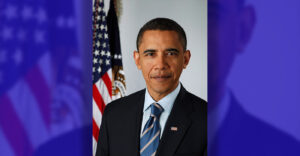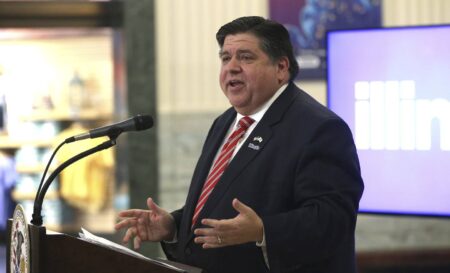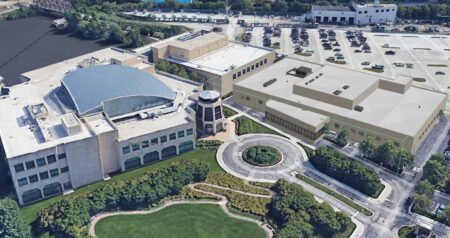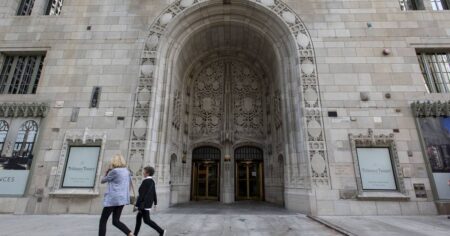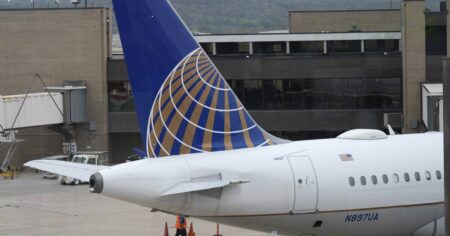Subscribe to Updates
Get the latest creative news from FooBar about art, design and business.
Browsing: Business
A 19th-century, Italianate-style mansion on more than 2.5 acres in the South Side Morgan Park neighborhood sold on March 28 for $625,000.Known alternately as the Hopkinson House or the Platt House after the surnames of early owners, the five-bedroom, 4,428-square-foot structure sits on one of the largest land sizes of any single-family home inside Chicago’s city limits.AdvertisementThe property includes five separate parcels of record, including several properties that extend into the middle of the block, between the backyards of neighboring houses.The year that the home, on South Drew Street, was built is in question. Early Tribune articles state that the house was built in 1845, while research provided by listing agent Nancy Hotchkiss of Berkshire Hathaway HomeServices, including a plaque in the home, pegs the home’s construction date to 1862. Either way, the house has been reported over the years to be the oldest home in the greater Beverly and Morgan Park area.AdvertisementThe house’s first owner was William Hopkinson, and a 1963 Tribune article claimed that the house was a station on the Underground Railroad.In the mid-1920s, Robert Platt, a University of Chicago geography professor, and his wife, Harriet, bought the house and remained there until his death in 1964. A 1989 Tribune article noted that the land once was used as a Potawatomi tribe council site.During the Platts’ ownership of the home, more than 100 U. of C. students lived in the Platts’ home, free of charge, according to Robert Platt’s 1964 Tribune obituary.The house has 3-1/2 bathrooms, two fireplaces, hardwood floors, original moldings and plasterwork.“You walk in the front door, and you’re awestruck,” Hotchkiss said. “It does need work, but it’s impressive and amazing and so unique and different. The couple who bought it is great and amazing and are going to keep the character alive. They’re so into the house and into the history. They wrote a lovely letter to the seller stating their intention to restore the house and keep the original integrity intact.”Hotchkiss’ client paid $735,000 in 2004 for the property.“He purchased it because he was afraid it would be lost,” Hotchkiss said of the seller. “He wanted to just keep it. It has so much history, and he just wanted to make sure it went to the right person.”The five parcels collectively had a $22,676 property tax bill in the 2020 tax year.AdvertisementGoldsborough is a freelance writer.Join our Chicago Dream Homes Facebook group for more luxury listings and real estate news.
Chicago concert promoter Jam Productions has partnered with a Los Angeles-based investment group.Jam, which operates venues such as the Vic Theatre, the Riviera Theatre and Park West in Chicago, recently celebrated its 50th year in business as one of the largest independent producers of live entertainment in the U.S. It also owns and is behind the renovation of the Uptown Theatre in the Uptown neighborhood, and operates The Palace in St. Paul, Minnesota. It is owned by Jerry Mickelson, who cofounded Jam in 1972 with Arny Granat, who left the company in 2019.Advertisement“It has been obvious that for Jam’s business to grow, it needed to be part of a network, something larger with more locations, data and intelligence analytics as well as booking leverage,” Jam co-founder Jerry Mickelson said. “Over the years I considered all the bigger players but there wasn’t a good fit in terms of how we wanted to operate and compete.”Jerry Mickelson in the lobby of the shuttered Uptown Theatre in Chicago in 2010. (Chris Walker / Chicago Tribune)Jam has sold an equity stake to SaveLive, a California group founded in 2020 and headed by CEO Marc Geiger. Its announcement of the sale calls Jam a “crown jewel in the SaveLive network. Jam and SaveLive intend to aggressively invest in the Midwest targeting small-to-midsize venues across multiple cities.” Coming out of the music industry’s pandemic pause, Jam anticipates producing 450 concerts in 33 venues in the Midwest.AdvertisementMickelson will retain control of Jam and continue to make operational decisions for the company, according to a report in Crain’s Chicago Business.“It’s exciting to reinvent Jam by aligning with a national company outside of our comfort zone and built differently than ours,” Mickelson said. “We blazed a trail and were always focused on the city’s neighborhoods and on bands who were just starting out. We very much played a part in defining the modern concert business and it’s not over. We’re going to continue to grow and adapt for the next 50 years with SaveLive.”SaveLive’s current partners include The Alibi and Golden State Theatre in California; Beer City Music Hall, Ponyboy, Tower Theatre and Criterion in Oklahoma City; and Elektricity in Pontiac, Michigan, among others. In a statement, it describes itself as founded “to bring scalable services and advantages to independent venue owners” — services including booking, ticketing, marketing, food and beverage, technology and sales and sponsorship.“Jam’s platform is a natural next step in building a quality national independent network,” Geiger said. “Jerry’s tenacity over the years of consolidation has been inspiring and we are super excited to integrate and get to work.”Geiger was also a co-founder of Lollapalooza in 1991, and lead the William Morris Endeavor music division from 2003 until 2020.Update: This story has been changed with new information about the partnership and Mickelson’s continued role at Jam.
Illinois on Thursday received its third credit upgrade in less than a year after previously going more than two decades without one, bolstering Gov. J.B. Pritzker’s reelection campaign message that he and fellow Democrats are slowly fixing the state’s long-running financial problems.Even with the upgrade, Moody’s Investors Service said Illinois’ credit remains lower than any other state in the nation. That’s in large part due to the state’s long-term debt issues, including pensions that remain significantly underfunded, and its sluggish economy relative to other states.AdvertisementStill, Pritzker publicized the bump as he announced the news at the Thompson Center in the Loop.Gov. J.B. Pritzker announces a new Illinois tourism campaign at the Shedd Aquarium in Chicago on April 18, 2022. (Antonio Perez / Chicago Tribune)“There is more work to be done, of course, but step by step, rung by rung, we are steadily climbing the ladder out of the hole that was dug over decades, and Illinois’ future is bright,” Pritzker said.AdvertisementThursday’s credit hike from Moody’s comes after the ratings agency last year elevated the state’s credit to two notches above junk bond status from one, the first upgrade for Illinois since Republican George Ryan was governor. S&P Global Ratings followed suit soon after, and while Fitch Ratings still has Illinois at its lowest investment grade, the firm has signaled an upgrade could be in the offing.Higher bond ratings mean the state generally is able to borrow money at lower interest rates, ultimately saving money for taxpayers.The positive financial news gave Pritzker another opportunity to tout the $46 billion state budget and $1.8 billion election-year tax relief plan he signed into law Tuesday — a plan he’s repeatedly promoting in TV commercials for his reelection campaign.The spending plan for the budget year that begins July 1 and other measures are allowing the state to deposit $1 billion into its rainy day fund, make an additional pension payment of $500 million on top of a required $9.6 billion contribution, and devote more than $1 billion toward paying off old employee health insurance bills.The state also has paid off $3.2 billion in emergency coronavirus loans from the Federal Reserve ahead of schedule and, using federal aid from President Joe Biden’s American Rescue Plan, paid down $2.7 billion of a $4.5 billion deficit in its unemployment insurance trust fund.“When I came into office, Illinois had a structural deficit of nearly $3 billion, and between 2015 and 2017 our state suffered an astonishing eight credit downgrades,” Pritzker said. “We’ve now repeatedly balanced the budget and secured three upgrades in under a year.”Still, the state has nearly $140 billion in unfunded pension liabilities and has yet to come up with a plan to repay the remaining $1.8 billion unemployment fund debt, among other challenges.House Speaker Emanuel “Chris” Welch, a Hillside Democrat who is looking to defend a 73-45 supermajority over Republicans, joined Pritzker in pinning the blame for the state’s money problems on past legislatures and governors, particularly Republican predecessor Bruce Rauner.AdvertisementDemocrats have “turned Bruce Rauner’s $17 billion debt into a surplus, and now we’re using that financial stability to make historic investments in human services and public safety, and put money back into the pockets of hardworking families,” Welch said in a statement, referring to the state’s previously towering pile of backlogged bills.Despite the plaudits from Wall Street, Republicans said massive federal stimulus efforts, including $8.1 billion last year from the American Rescue Plan, have papered over deeper budgetary problems.“The truth is, Pritzker continues to put Illinois on a path toward fiscal insolvency by increasing state spending and failing to address the systemic issues that are causing people to flee this state,” Senate GOP leader Dan McConchie of Hawthorn Woods said in a statement. “Should he remain in office next year, he is going to be confronted with a major hangover after the federal money dries up and state spending is at a record high.”The larger economic issues cited by Republicans are factored into the Moody’s analysis and the ratings agencies have so far given the General Assembly and the Pritzker administration credit for not using the one-time influx of revenue to fund ongoing expenses.In addition to the rating upgrade, Moody’s affirmed its stable outlook for Illinois’ finances, which “balances the state’s recent financial progress with underlying challenges that will remain in place for some time.”An earlier version of this story gave an incorrect figure for Illinois’ pension debt.Advertisementdpetrella@chicagotribune.comSign up for The Spin to get the top stories in politics delivered to your inbox weekday afternoons.
Mars Wrigley announced Thursday it would build a new research and development facility on Goose Island, the site of the company’s global headquarters.The company, which makes candies including M&Ms, Skittles, Snickers and Twix, said the development will make Chicago its largest innovation hub in the world.AdvertisementConstruction on the research hub is scheduled to begin this summer and be completed by summer 2023. It is expected to cost about $40 million, according to spokesperson Jonathan Guerin.Mars Wrigley announced Thursday that it will build a $40 million research and development facility, pictured here in a rendering to the right of the roundabout next to the company’s existing innovation center on Goose Island. The development will make Chicago the company’s largest innovation hub in the world. (Mars Wrigley / HANDOUT)The facility will be built next to the company’s existing global innovation center on Goose Island, which opened in 2005 and where Mars already employs more than 450 people. About 950 people work on the company’s Goose Island campus in total. The company said the new facility will bring about 30 jobs to Chicago.AdvertisementGuerin said in an email the new research hub would “expand to inspire the next generation of new products to support the company’s iconic global snacks and treats brands.” Research and development at the existing facility is focused on fruity, gum and mints products, Guerin said.“Mars has made Chicago home to innovation for nearly 100 years, producing some of the world’s most beloved and iconic snacks and treats,” Chris Rowe, global vice president of research and development, said in a statement. “Creating new jobs and a world-class, multimillion-dollar research and development hub demonstrates our ongoing commitment to the Chicagoland area and accelerates our future for innovation.”Mars acquired Chicago-based Wrigley in 2008. The company’s U.S. headquarters moved to New Jersey in 2017, though its global headquarters is on Goose Island.In January, Mars Wrigley announced it was closing a historic chocolate plant in Galewood on the city’s West Side. The plant, which as of January employed about 280 people, will be phased out over the next two years, the company said at the time.Some of the company’s other Illinois manufacturing locations include an ice cream factory in Burr Ridge, a candy factory in Yorkville and a pet nutrition manufacturing site in Mattoon. Mars employs just under 4,000 people in Illinois.tasoglin@chicagotribune.com
Judith McKenna, who is president and CEO of Walmart’s international division, and her husband Philip Dutton, on March 30 paid $4.9 million for a condominium on the 20th floor of the recently converted Tribune Tower.McKenna has been the head of Walmart’s overseas operations since 2018, and previously was chief operating officer for Walmart’s U.S. business.AdvertisementMcKenna is based in Bentonville, Ark., where Walmart has its headquarters. Elite Street could not determine why she and her husband decided to buy a place in Chicago, and a Walmart spokesman declined to comment.McKenna and Dutton bought the unit from the developers, Golub & Co. and CIM Group, which have converted the Tribune Tower from offices to condos. As a result, no details are available about the features in the unit.AdvertisementMcKenna and her husband also own a 6,500-square-foot house on 3.24 acres in Bentonville, which they have owned since buying it in 2013 for $1.1 million, according to the local assessor.Goldsborough is a freelance writer.Join our Chicago Dream Homes Facebook group for more luxury listings and real estate news.
Notice: Undefined index: file in /home/ofzfvenynm4q/public_html/wp-content/themes/smart-mag/inc/media.php on line 688
A former paralegal who worked in bankruptcy at a Chicago law firm is accused of embezzling more than $600,000 from accounts, officials said Thursday.Becky Louise Sutton, 66, formerly of Park Forest, is charged with three counts of wire fraud and three counts of embezzlement from the estate of a debtor, according to a statement from the U.S. attorney’s office in Chicago.AdvertisementAn indictment was returned Wednesday for Sutton, of Austin, Texas, who embezzled the money from 2009 to 2018 while she worked at the law firm, according to the statement.Sutton placed “fraudulent transfers” of bankruptcy funds from fiduciary bank accounts intended for creditors to accounts she handled — including her own personal bank account, credit card account, student loan account and mortgage, the statement said.AdvertisementIn one instance, Sutton used a company with a name similar to a creditor to disguise her transfer of the money, according to the statement, which said the indictment seeks forfeiture from Sutton of $611,263 in alleged criminally derived proceeds.Reached by phone Thursday evening, a lawyer representing Sutton, Gal Pissetzsky, said Sutton plans on pleading not guilty and declined to immediately elaborate. “She was just indicted today…we’re going to wait until we get the discovery,” Pissetzsky said. Sutton’s arraignment in federal court in Chicago has not yet been scheduled.rsobol@chicagotribune.com
Notice: Undefined index: file in /home/ofzfvenynm4q/public_html/wp-content/themes/smart-mag/inc/media.php on line 688
The burgeoning Chicago tech scene has a new player: the Department of Defense.The Defense Innovation Unit, a military technology accelerator, is opening an office in Chicago to tap into the region’s technology ecosystem, from electric vehicles to artificial intelligence, and better wage 21st century warfare.AdvertisementThe office will be located at the Discovery Partners Institute offices on South Wacker Drive for a two-year lease beginning in June, the Defense Department announced Thursday. The commitment to developing a stronger tech innovation pipeline in Chicago and the Midwest is long term, according to Michael Brown, director of the innovation unit.The Defense Department brought in 100 new vendors last year, mostly from other regions, Brown said. The new innovation hub should significantly boost the representation of Midwest tech companies as Defense Department contractors.Advertisement“We brought in 15 from this region, and we’re looking to triple that over the next couple of years,” Brown said during the announcement Thursday at MxD, a digital manufacturing innovation center at Goose Island.The Chicago office will be the fifth for the Defense Department, which has innovation units in Silicon Valley, Boston, Austin and at the Pentagon. Founded in 2015, the Defense Innovation Unit was established to find, develop and employ new technology to speed up adoption and enhance national security.It is also being touted as a boost to Chicago’s technology scene, from academic institutions and innovation centers to startup companies.“We want to open DoD as a viable market for business, to startups that today don’t understand they can do business with the department,” said Ryan Whelan, a U.S. Army Reserve major who heads up the Midwest region for the innovation unit. “The other thing that we want to do is accelerate the growth of these emerging technologies by creating new opportunity for commercial tech and accelerating its adoption in the defense space.”Whelan said new technologies, from electric vehicles to agricultural technology, can strengthen national security and help the U.S. “fight wars better” as it competes with countries such as China, Russia and others.Those sentiments were echoed by a full roster of Illinois political leaders, including Gov. J.B. Pritzker, Mayor Lori Lightfoot and both Illinois senators, who were on hand Thursday for the defense innovation hub announcement.U.S. Sen. Tammy Duckworth, an Iraq War veteran who serves on the Armed Services Committee, said the innovation unit enables the military to leverage new technologies and level the battlefield.“We’re putting our troops at risk of losing battles if we don’t invest in the technologies that will help us to compete in the next century’s battlefield,” Duckworth said. “Whether that’s an island in Southeast Asia or a piece of code that holds up our electrical grid, I know firsthand how important it is to have all of the resources possible when on the battlefield.”AdvertisementU.S. Sen. Dick Durbin said the Chicago office will be a boon for the state and the Midwest, and a resource for national defense. He said the development of EV technology in Illinois, specifically the launch of the Rivian truck manufacturing plant in Normal, could find applications on the battlefield.The Rivian facility, which launched production in September, is building $70,000 electric trucks and SUVs for consumer use.“They can go straight from the assembly line in Normal to driving through rivers, even rock crawling up mountains,” Durbin said. “Just imagine how useful that vehicle could be on the battlefield.”The Chicago defense innovation hub will occupy a small footprint in the Discovery Partners Institute offices, with room for five or six employees, the Defense Department said. It will likely need to find new quarters when the two-year lease is up.The Discovery Partners Institute, a University of Illinois-led initiative, is building a 500,000-square-foot innovation hub to develop Chicago tech talent at The 78, a 62-acre megadevelopment slated for long-vacant land in the South Loop. The facility is slated to open on the south end of The 78 by 2024.Whelan declined to say if the Defense Innovation Unit would follow the Discovery Partners Institute to its new digs. If it does, it may have a casino for a neighbor. Chicago-based Rush Street Gaming, which owns four casinos including Rivers Casino Des Plaines, is proposing a $1.62 billion riverfront casino at The 78, one of three bids in contention to become Chicago’s first gambling mecca.Advertisementrchannick@chicagotribune.com
CHICAGO — United Airlines reported Wednesday that it lost $1.38 billion in the first quarter of 2022 but said it expects to return to profitability in the current three-month period as post-pandemic travel ramps back up.The Chicago-based airline posted revenue of $7.67 billion in the quarter that ended March 31. That was down 21% from the first quarter of 2019.AdvertisementThe airline is still running fewer flights than before the pandemic. But it said it had reopened all of its lounges, resumed 19 international routes and restarted services to six cities that haven’t been served since the pandemic began.The number of miles flown by paying passengers fell 27% from a year earlier. However United is flying with roughly 73% of its available seats full. While not as high as the 81% of all seats before the pandemic, it is much better than it was in 2021 first quarter, when roughly half of all seats were filled with paying passengers.AdvertisementThe first quarter started off troubled for the airline industry, dominated in the early weeks by omicron variant of the COVID-19 virus. The virus abated, and caseloads across the U.S. have been low for some time. A federal judge this week put an injunction on the government’s mask mandate on planes, trains and travel hubs but the Justice Department said Wednesday it is filing an appeal seeking to overturn the order.“We continue to believe we will see a strong spring and lead in to summer as restrictions disappear and more people travel,” said analysts at Cowen & Co. “We believe if the U.S. testing mandate were to be eliminated, we would see strong pent-up demand for the summer on trans-Atlantic routes.”The airline appeared optimistic that its pandemic-related losses were behind it. United said it expects to post a profit for the second quarter and for the full year 2022. This is despite United facing higher fuel costs this quarter, paying on average $2.88 for fuel, up 40% from a year earlier. The airline forecast an operating gross margin of 10%, which was above analysts’ expectations.“The demand environment is the strongest it’s been in my 30 years in the industry … we’re now seeing clear evidence that the second quarter will be a historic inflection point for our business,” United Airlines CEO Scott Kirby said in a statement.United’s quarterly loss amounted to $4.24 a share and compared to a loss of $1.36 billion, or $4.29 a share, in the same period a year earlier. Analysts had been expecting a loss of $4.22 a share in the latest quarter, according to FactSet.
Charles Evans will retire early next year after 15 years as president of the Federal Reserve Bank of Chicago, a tenure that made him the longest-serving current regional Fed president, the bank announced Thursday.Among Fed officials, Evans has been a vocal supporter of lower interest rates. His departure comes as the Fed is wrestling with how quickly and how high to boost its benchmark short-term rate in its fight against inflation, which is at its worst level in four decades.AdvertisementRegional Fed presidents like Evans take part in the central bank’s eight policymaking meetings each year. But every year, on a rotating basis, just four of the 12 regional bank presidents have a vote on the central bank’s interest rate decisions. The Chicago Fed president will have a vote next year.Charles Evans, President and CEO of the Federal Reserve Bank of Chicago, speaks at the Council on Foreign Relations, in New York, Wednesday, Nov. 6, 2019. Evans, president of the Federal Reserve Bank of Chicago, said Thursday, April 21, 2022, that he will retire early next year, after 15 years in the position that has left him the longest-serving regional bank president. (Richard Drew/AP)In a statement, the Chicago Fed described Evans as a “strong supporter” of improving the central bank’s communication with the public. It also noted that he helped develop the Fed’s so-called “dot plot,” which four times a year anonymously displays each Fed official’s preferred path for interest rates in the coming years.AdvertisementThe Chicago Fed said it has formed a search committee for Evans’ replacement, led by Helene Gayle, CEO of the Chicago Community Trust, a nonprofit group, and David Habiger, CEO of JD Power, an auto review website.Evans’ departure is unlikely to lead to any significant shift in the Fed’s policymaking, said Michael Pugliese, an economist at Wells Fargo.“I would not anticipate us making any major changes to our monetary policy forecast,” Pugliese said, referring to Wells Fargo’s outlook.
Elon Musk says he has lined up $46.5 billion in financing to buy Twitter, and he’s trying to negotiate an agreement with the company.Last week, Musk announced an offer to buy the social media company for $54.20 per share, or about $43 billion. At the time, he did not say how he would finance the acquisition.AdvertisementThe Tesla CEO said Thursday in documents filed with U.S. securities regulators that he’s exploring what’s known as a tender offer to buy all of the social media platform’s common stock for $54.20 per share in cash. Under a tender offer, Musk, who owns about 9% of Twitter shares, would take his offer directly to other shareholders, bypassing the board.But Musk hasn’t decided yet whether to do that.AdvertisementThe documents filed with the Securities and Exchange Commission say San Francisco-based Twitter Inc. has not responded to Musk’s proposal.Last week Twitter’s board adopted a “poison pill” defense that could make a takeover attempt prohibitively expensive.The filing states that “entities related to (Musk) have received commitment letters committing to provide an aggregate of approximately $46.5 billion.”The financing would come from Morgan Stanley and other financial institutions. Some would be secured by stock that Musk owns in Tesla, the electric car and solar panel maker. Other banks involved include Barclays, Bank of America, Societie Generale, Mizuho Bank, BNP Paribas and MUFG.Shares of Twitter were down slightly to $46.69 in Thursday morning trading after the financing became public. The share price is $7.51 below Musk’s offer.Musk “is seeking to negotiate a definitive agreement for the acquisition of Twitter … and is prepared to begin such negotiations immediately,” the documents say.With a tender offer, Musk would try to get other shareholders to pledge their stock to him at a certain price on a certain date. If enough shareholders agree, Musk could use that as leverage to get the board to drop the poison pill defense.Musk signaled the possibility of a tender offer several times this week in tweets using the word “tender.”


